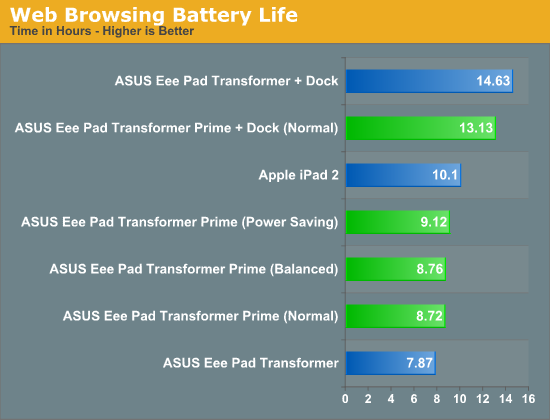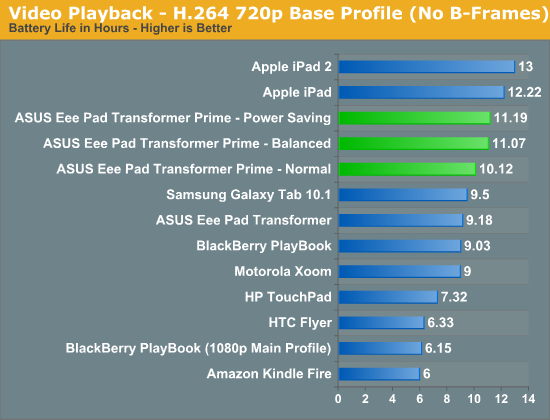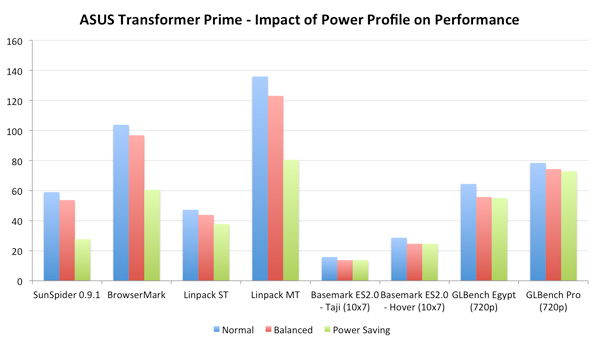ASUS Eee Pad Transformer Prime Review Part II: Battery Life & More
by Anand Lal Shimpi on December 15, 2011 3:45 AM ESTThe Final Word on Battery Life
In our iPhone 4S review I mentioned that our web browsing battery life tests were in dire need of an update. The move to iOS 5 increased the aggressiveness of browser side caching, which impacted our old tests significantly. We still have plans for a much more significant departure from our existing battery life testing methodology, however as an interim solution I developed a modified version of our traditional smartphone battery life test.
The old web browsing test lacked any significant cache busting features and the HTML workload itself was more representative of mobile sites than a full desktop experience. The modified test does a much better job of not allowing its components to be cached by the browser, and includes both lighter and full desktop websites. Since the workload has changed, these numbers are no longer comparable to those running the older version of our test. The new web browsing test is also stressful enough to span both smartphones and tablets, whereas before we had a separate version just for tablets.
Finally, I must mention that we ensure all tablets tested here are normalized to the same display brightness setting of 200 nits for a true apples to apples comparison. As always we rely on the stock web browser that ships with the platform and manually quit all background tasks before running our tests. In the case of the Transformer Prime, I was able to run our new battery life test using all three power profiles to get a better idea of the range of battery life. As a recap, here are the details on the power profiles.
ASUS and NVIDIA have defined three power profiles on the Prime: Normal, Balanced, and Power Saving. Normal allows the CPU to run at up to 1.4GHz with only a single core active, and 1.3GHz otherwise. Balanced is the default setting and it drops maximum CPU clock to 1.2GHz and favors lower clock/voltage targets on the curve compared to Normal mode. Power Saving caps CPU frequency at 1GHz with 1—2 cores active, 760MHz with 3 cores active and 620MHz with 4 cores active. It's unclear what the impact is on GPU clocks/performance. I've also noticed that the Power Saving profile also enables a dynamic contrast control that you can't override.

The shipping Prime does much better than the original tablet I reviewed a couple of weeks ago. It's clear that whatever was impacting WiFi performance also took its toll on battery life. What I suspected might be the case ended up being true: the implementation of Tegra 3 in the Transformer Prime delivers better battery life than Tegra 2 in the original Eee Pad Transformer. There are too many variables here for me to attribute the gains to NVIDIA's SoC alone, but seeing as how battery capacity hasn't changed it's likely that we do have Tegra 3 to thank for better battery life in the TF Prime.
Note that even running in Normal mode and allowing all four cores to run at up to 1.3GHz, Tegra 3 is able to post better battery life than Tegra 2. I suspect this is because NVIDIA is able to parallelize some of the web page loading process across all four cores, delivering similar performance to the original Transformer but at lower frequency/voltage settings across all of the cores. Additional performance gained by supporting NEON likely helps improve efficiency, not to mention higher single-threaded performance thanks to Tegra 3's higher clocks. Combine all of this with a more mature 40nm process and a more mature Cortex A9 implementation on that process, and the power improvements make sense.
The Transformer Prime is still unable to dethrone the iPad 2 here, which just goes to show you how efficient Apple's platform was to begin with. That being said, the Prime is within striking distance of Apple's tablet. The race is now close enough where you won't notice too much of a difference between the two.
There's also not a huge difference in battery life between the various power profiles. I do applaud ASUS and NVIDIA for giving us control over the CPU governor, but unless you're trying to make the tablet last over a very long flight you're probably fine just leaving it in Normal mode and enjoying the extra performance.
I included results from the Prime running with its dock attached. The additional 22Wh battery improved battery life by 51%. The scaling isn't linear because the dock itself draws power. Once the dock's battery is depleted, the tablet needs to power both itself and the dock. The improvement is tangible though, if you need to do a lot of writing on a flight around the world the dock will help you get there.
Video playback battery life is much better than the original Eee Pad Transformer. Tegra 2 was clearly broken when it came to its video decode abilities and as a result we saw significant limitations on both what video you could play and how long you could play them. Tegra 3 fixes all of that, and the result is battery life that's getting closer to the iPad 2:

Getting 11 hours of continuous video playback battery life is something to be proud of. Being able to watch 4-6 full length movies on a plane without worrying about your battery is a pretty nice feature. Unlike the active use case, video playback seems to see a bigger benefit from switching away from the Normal power profile.











58 Comments
View All Comments
medi01 - Thursday, December 15, 2011 - link
It's not about "what is Prime's color gamut", but rather "how does it compare to other tablets".Hopefully it will become standard part of your tests, since brightness/contrast tell only small part of the story.
Ric_Margiotta - Thursday, December 15, 2011 - link
Thanks for this follow-up article, Anand! It was a good read and answered some of my remaining questions about the TF Prime. Still looking forward to picking one of these up in January!sotoa - Thursday, December 15, 2011 - link
Too bad these weren't ready in bulk for Christmas. Not to mention ICS.tipoo - Thursday, December 15, 2011 - link
I read elsewhere that engineering samples of Tegra 3 weren't performing as much better as Nvidia originally expected them to, due to the cores and GPU being constrained for memory bandwidth. I don't know of them changing this in the original design. I'm curious how much ICS will improve T3 performance with its better multithreading and better GPU acceleration, and how much comes down to all the elements competing for bandwidth or some other hardware limitation?druter - Thursday, December 15, 2011 - link
I guess we should not have expected a non apple slanted review from such a mac fanboy site. I dispair for tech journalism when the point becomes less about an honest unbiased review and more about ones allegiance to apple.Nice try though to sound unbiased though, stating that it is a much improved tablet, your apple bias showed through though when you indicated you felt that it was only in comparison to other Androids and that it was still below anything Mac.
The lesson I learned don't come to Anandtech.com when you want an honest unbiased review.
piiman - Thursday, December 15, 2011 - link
If you think this is an Apple fan site why do you even come here? Just so you can bash the reviews?tipoo - Thursday, December 15, 2011 - link
What parts of this came across as biased? To me it seemed all the facts were laid out impartially, and they put effort into correcting the old battery life measurements as well as promised performance updates when ICS hits. If everything comes back to the iPad, its for a reason, like it or not its still the standards bearer for these tablets, and I'm a hardcore Android user. I think the Prime will be better than the iPad personally when ICS hits, but the review is based on current software of course.IKeelU - Thursday, December 15, 2011 - link
It's important to show how it performs against the iPad, especially with regards to battery life. Most people don't care about android vs iOS, they just want a media consumption device, and will therefore choose the device that allows them to do that better.Second, the numbers for battery life are in Apple's favor. It would be biased to ignore them.
Sounds to me like you would be better served by going to an Android fanboy website.
Belard - Thursday, December 15, 2011 - link
You are a fool druter. I and others do not know WHAT you think you read or watched.A) Anand isn't much of a tablet user (AFAIK from his previous articles)
B) He uses all kinds of technology - he does have the right to use what he wants for his personal uses, no? He uses AMD and intel for his own servers and in general - has kept standards pretty good on this sight.
C) All devices WILL compare market leaders, including the iPad. With what is on the market TODAY from Samsung, ASUS, Toshiba, etc - None of them have the battery or GPU (graphics) performance of the 9 month old iPad2 and some are below that of an iPad1 especially when it comes to battery life.
D) "below anything mac"?? he didn't compare the TF-Prime to any Mac. Apple only has one type of tablet on the market and its NOT a Macintosh. He stated the simple fact that tablets DO NOT replace actual notebooks. That is true if the iPad2 as well.
E) Use the best tool for the job or personal preference and budget. Simple as that, eh? I build my own desktops, own ThinkPad notebooks and have an iPad. My dislike for apple is the same for Microsoft, so it just doesn't matter.
F) Get over yourself.
melgross - Thursday, December 15, 2011 - link
Some people aren't happy unless something is reviewed as being much better than any comparable Apple product.Like it or not, the iPad is still the gold standard, and everything is going to be compared to that. This guy will be very unhappy in March when the new one comes out.